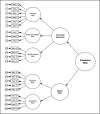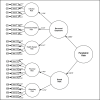A Pandemic Risk Perception Scale
- PMID: 34374448
- PMCID: PMC8447355
- DOI: 10.1111/risa.13802
A Pandemic Risk Perception Scale
Abstract
We propose a Pandemic Risk Perception Scale. Our scale comprises two constructs, Dread Risk and Personal Exposure, divided into five dimensions: Infection Risk, Emotional Health Risk, Health System Risk,Financial Risk, and Alimentary Risk. Using multidimensional item response theory, confirmatory factor analysis, and structural equation modeling on two samples of respondents, our results show that Alimentary Risk, Health System Risk, and Emotional Health Risk are the main dimensions of risk perception for the COVID-19 pandemic. Furthermore, Infection Risk has a minor impact on the pandemic's risk perception, suggesting the presence of different dynamics between personal and general risk perceptions for the COVID-19 pandemic.
Keywords: COVID-19; Health crisis; pandemic events; risk perception.
© 2021 Society for Risk Analysis.
Figures



Similar articles
-
The Outrage Effect of Personal Stake, Effect on Children, Dread, and Controllability on COVID-19 Risk Perception Moderated by Media Use.Health Commun. 2024 Oct;39(11):2346-2355. doi: 10.1080/10410236.2023.2267275. Epub 2023 Oct 13. Health Commun. 2024. PMID: 37828904
-
The cancer patient's perspective of COVID-19-induced distress-A cross-sectional study and a longitudinal comparison of HRQOL assessed before and during the pandemic.Cancer Med. 2021 Jun;10(12):3928-3937. doi: 10.1002/cam4.3950. Epub 2021 May 10. Cancer Med. 2021. PMID: 33973411 Free PMC article.
-
Treatment adherence during the COVID-19 pandemic and the impact of confinement on disease activity and emotional status: A survey in 644 rheumatic patients.Joint Bone Spine. 2021 Mar;88(2):105085. doi: 10.1016/j.jbspin.2020.105085. Epub 2020 Oct 27. Joint Bone Spine. 2021. PMID: 33127460 Free PMC article. No abstract available.
-
Things must not fall apart: the ripple effects of the COVID-19 pandemic on children in sub-Saharan Africa.Pediatr Res. 2021 Apr;89(5):1078-1086. doi: 10.1038/s41390-020-01174-y. Epub 2020 Sep 24. Pediatr Res. 2021. PMID: 32971527 Free PMC article. Review.
-
Integrating Risk Assessment and Decision-Making Methods in Analyzing the Dynamics of COVID-19 Epidemics in Davao City, Mindanao Island, Philippines.Risk Anal. 2022 Jan;42(1):105-125. doi: 10.1111/risa.13779. Epub 2021 Jul 16. Risk Anal. 2022. PMID: 34269475 Free PMC article. Review.
Cited by
-
Barriers and facilitators of complications risk perception among rural patients with type 2 diabetes mellitus: a qualitative content analysis.BMC Public Health. 2025 Mar 24;25(1):1110. doi: 10.1186/s12889-025-22299-x. BMC Public Health. 2025. PMID: 40128771 Free PMC article.
-
Positive relationship between education level and risk perception and behavioral response: A machine learning approach.PLoS One. 2025 Apr 3;20(4):e0321153. doi: 10.1371/journal.pone.0321153. eCollection 2025. PLoS One. 2025. PMID: 40179062 Free PMC article.
-
Global systemic risk and resilience for novel coronavirus in postpandemic era.Risk Anal. 2022 Jan;42(1):1-4. doi: 10.1111/risa.13873. Risk Anal. 2022. PMID: 35152452 Free PMC article.
-
A fully integrated duplex RT-LAMP device for the detection of viral infections.Biomed Microdevices. 2023 Sep 8;25(4):36. doi: 10.1007/s10544-023-00676-w. Biomed Microdevices. 2023. PMID: 37682413 Free PMC article.
-
Evolution Model and Simulation Study of the Public Risk Perception of COVID-19.Int J Environ Res Public Health. 2022 Sep 14;19(18):11581. doi: 10.3390/ijerph191811581. Int J Environ Res Public Health. 2022. PMID: 36141849 Free PMC article.
References
-
- Asparouhov, T. , & Muthen, B. (2010). Simple second order chi‐square correction. Unpublished manuscript. Retrieved from https://www.statmodel.com/download/WLSMV_new_chi21.pdf
-
- Baker, F. (2001). The basics of item response theory. College Park, MD: ERIC Clearinghouse on Assessment and Evaluation, University of Maryland.
-
- Bronfman, N. C. , Cifuentes, L. A. , & Gutiérrez, V. V. (2008). Participant‐focused analysis: Explanatory power of the classic psychometric paradigm in risk perception. Journal of Risk Research, 11(6), 735–753.
Publication types
MeSH terms
LinkOut - more resources
Full Text Sources
Medical

